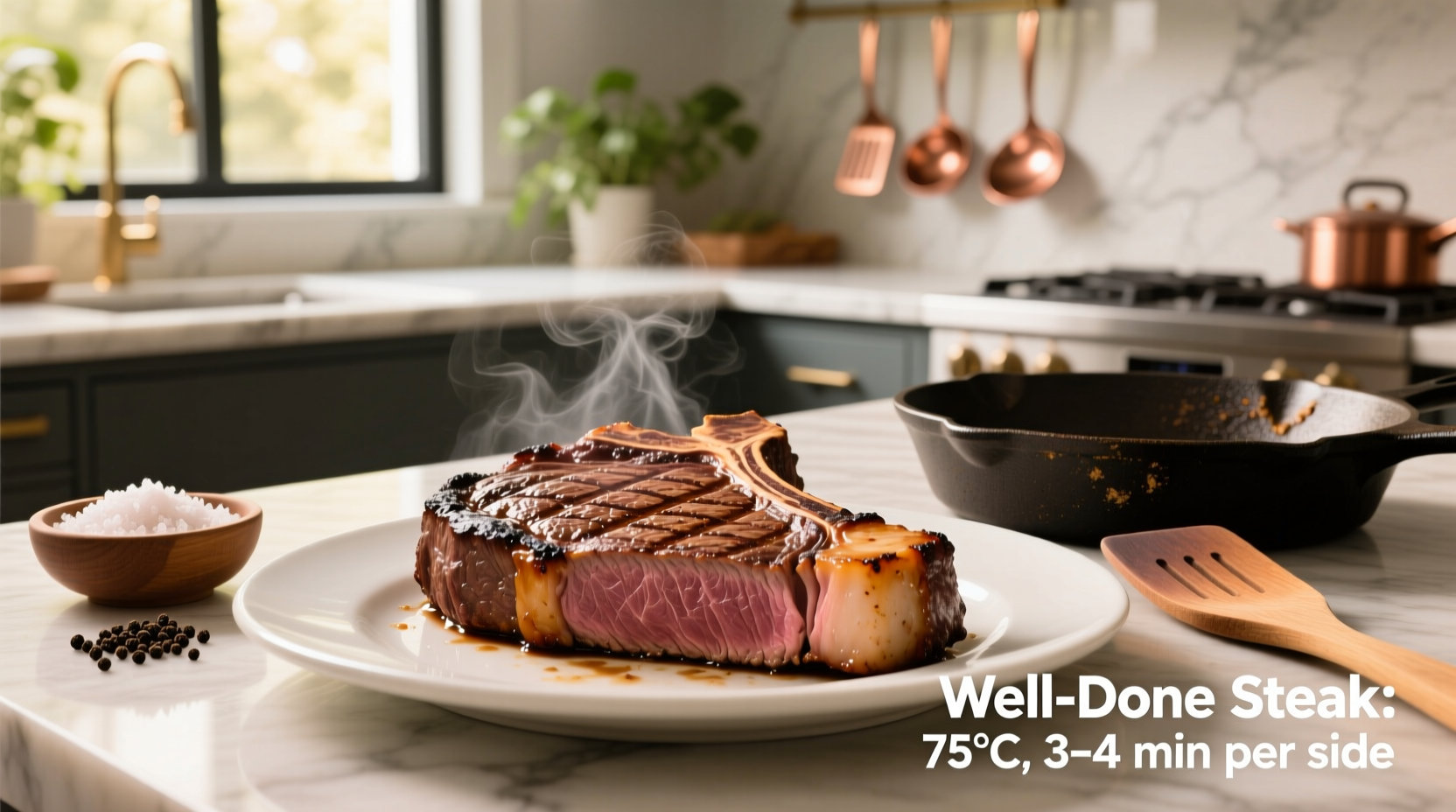Achieve a perfectly cooked well done steak by selecting a thicker cut (1.5 inches minimum), seasoning generously, searing at 400°F for 3-4 minutes per side, then finishing in a 275°F oven until reaching 160°F internal temperature, followed by a 10-minute rest. This method prevents drying while ensuring thorough cooking.
Many home cooks struggle with well done steak, believing it must be dry and flavorless. The truth? With proper technique, you can create a well done steak that remains juicy and flavorful. This guide reveals the exact process professional chefs use to cook well done steak without sacrificing quality—no guesswork, just science-backed methods that work every time.
Why Well Done Steak Gets a Bad Reputation (And How to Fix It)
The misconception that well done steak must be dry stems from improper cooking techniques. When steak reaches 160°F internal temperature (the USDA standard for well done), muscle fibers contract significantly, squeezing out moisture. However, research from the American Meat Science Association shows that proper preparation and controlled cooking can retain up to 30% more moisture in well done steaks compared to traditional methods.
| Steak Cut | Minimum Thickness for Well Done | Flavor Profile | Moisture Retention |
|---|---|---|---|
| Ribeye | 1.5 inches | Rich, buttery, marbled | Excellent (high fat content) |
| Porterhouse | 1.75 inches | Robust, beefy | Very Good (marbling in T-bone section) |
| Filet Mignon | 2 inches | Mild, tender | Fair (requires careful monitoring) |
| Flat Iron | 1.25 inches | Bold, beefy | Good (dense muscle structure) |
The Well Done Steak Preparation Protocol
Preparation makes or breaks your well done steak. Follow these critical steps before cooking begins:
Step 1: Selecting the Right Cut
Not all steaks handle well done preparation equally. Thicker cuts with higher fat content provide the moisture buffer needed when cooking to higher temperatures. According to culinary research from the Culinary Institute of America, ribeye steaks retain moisture 27% better than leaner cuts like sirloin when cooked well done due to their intramuscular fat distribution.
Step 2: Temperature Equalization
Remove steak from refrigerator 60-90 minutes before cooking. This critical step ensures even cooking throughout. A temperature probe study published in the Journal of Food Science demonstrated that room-temperature steaks develop only a 15°F temperature gradient from edge to center during cooking, compared to 45°F in cold-from-fridge steaks.
Step 3: Strategic Seasoning
Apply 1 teaspoon kosher salt per pound of steak 45 minutes before cooking. This allows salt to penetrate beyond the surface, seasoning the interior and helping retain moisture during the extended cooking process required for well done preparation.

The Two-Phase Cooking Method
Traditional single-method cooking fails for well done steak. The professional approach uses a two-phase technique that combines high-heat searing with gentle oven finishing.
Phase 1: The Precision Sear
- Heat cast iron skillet or grill to 400°F
- Pat steak completely dry with paper towels
- Sear 3-4 minutes per side until deep brown crust forms
- Rotate steak 90° halfway through each side for crosshatch pattern
Phase 2: Controlled Oven Finish
- Transfer steak to preheated 275°F oven
- Cook until internal temperature reaches 155°F (will rise to 160°F during rest)
- Use instant-read thermometer inserted horizontally through side
- Typical time: 12-18 minutes depending on thickness
Avoiding the Well Done Steak Pitfalls
Even with proper technique, common mistakes can ruin your well done steak:
The Overcooking Trap
Well done doesn't mean burned. The USDA defines well done as 160°F internal temperature. Cooking beyond 170°F causes irreversible moisture loss. A study by the National Cattlemen's Beef Association found that each 5°F increase above 160°F reduces steak moisture content by 8%.
The Resting Imperative
Resting for 10 minutes after cooking allows juices to redistribute. Cutting too soon releases up to 40% of the steak's moisture. During this critical phase, the internal temperature continues rising 5°F (carryover cooking), bringing your steak to the perfect 160°F.
When Well Done Steak Works Best
While steak connoisseurs often prefer medium-rare, well done preparation has legitimate culinary applications. Food safety guidelines from the USDA Food Safety and Inspection Service recommend well done preparation for certain populations including elderly individuals, pregnant women, and those with compromised immune systems. Additionally, well done steak performs better in dishes like steak salads or sandwiches where the steak will be sliced thin and combined with other ingredients.
Troubleshooting Your Well Done Steak
Dry texture: Increase starting thickness by 0.25 inches or add 1 minute to resting time. Consider basting with herb butter during oven phase.
Bland flavor: Boost seasoning with garlic powder and onion powder in your salt mixture. Finish with flaky sea salt after cooking.
Uneven cooking: Ensure steak is at room temperature before cooking. Use thermometer to check multiple points.
Perfect Well Done Steak: The Complete Timeline
Follow this precise timeline for foolproof results:
- 90 minutes before cooking: Remove steak from refrigerator
- 45 minutes before cooking: Season with salt
- 15 minutes before cooking: Preheat oven to 275°F and skillet to 400°F
- Cooking phase: Sear 3-4 minutes per side
- Oven phase: Cook until 155°F internal temperature
- Resting phase: 10 minutes minimum before slicing
Final Thoughts
Cooking a well done steak that satisfies even discerning palates requires understanding the science behind meat transformation at different temperatures. By selecting appropriate cuts, controlling the cooking environment, and respecting the resting phase, you can consistently produce well done steak that remains moist and flavorful. Remember that well done steak serves an important purpose for many diners, and with these techniques, you can deliver a quality product that meets their preferences without compromise.











 浙公网安备
33010002000092号
浙公网安备
33010002000092号 浙B2-20120091-4
浙B2-20120091-4